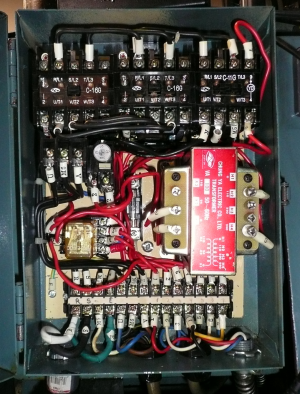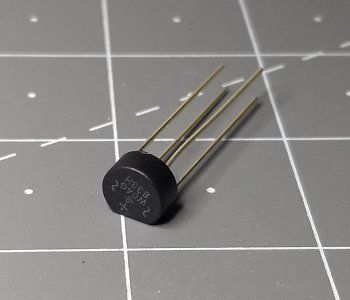First, everything works, but I'm looking for some information. This all references the picture posted below but doesn't show the front panel and FWD-OFF-REV switch up front. The configuration is one that appears to be found on a number of Taiwanese lathes. This one is a Frejoth but I've seen one labelled as a Rutland. 'Standard' config - the two top C-16G contactors are for motor Forward and Reverse, the C-11G provides the main power and emergency shutoff. There is an overload protection device below the C-16G on the left and the transformer has a 240VAC input (configurable) and a 24VAC and 110VAC output. The 110VAC output is not used. The 24VAC system passes current through the 5A fuse and operates the contactors and the small, clear plastic encased relay below the overload unit. That relay is the main issue. That small relay is a 24VDC relay and wired with a bridge rectifier (also pictured) with specs that match this picture and operates that relay coil. This small relay is the 24 volt subsystem that powers the front panel and Forward-Reverse switch to operate the contactors.
Here is the big question: Is there some advantage to operating this relay with 24 volts DC as opposed to not having the rectifier and using a normal 24 volt AC relay?
My first thought is there was a box of DC relays laying around and a $.50 rectifier made them usable as opposed to a $7 AC relay. What am I overlooking? I have both AC and DC replacement relays and I need to change the damaged relay socket anyway, so can I get rid of the extra rectifier wiring or leave it alone?
Thanks,
tjm
Here is the big question: Is there some advantage to operating this relay with 24 volts DC as opposed to not having the rectifier and using a normal 24 volt AC relay?
My first thought is there was a box of DC relays laying around and a $.50 rectifier made them usable as opposed to a $7 AC relay. What am I overlooking? I have both AC and DC replacement relays and I need to change the damaged relay socket anyway, so can I get rid of the extra rectifier wiring or leave it alone?
Thanks,
tjm
Attachments
Last edited:



